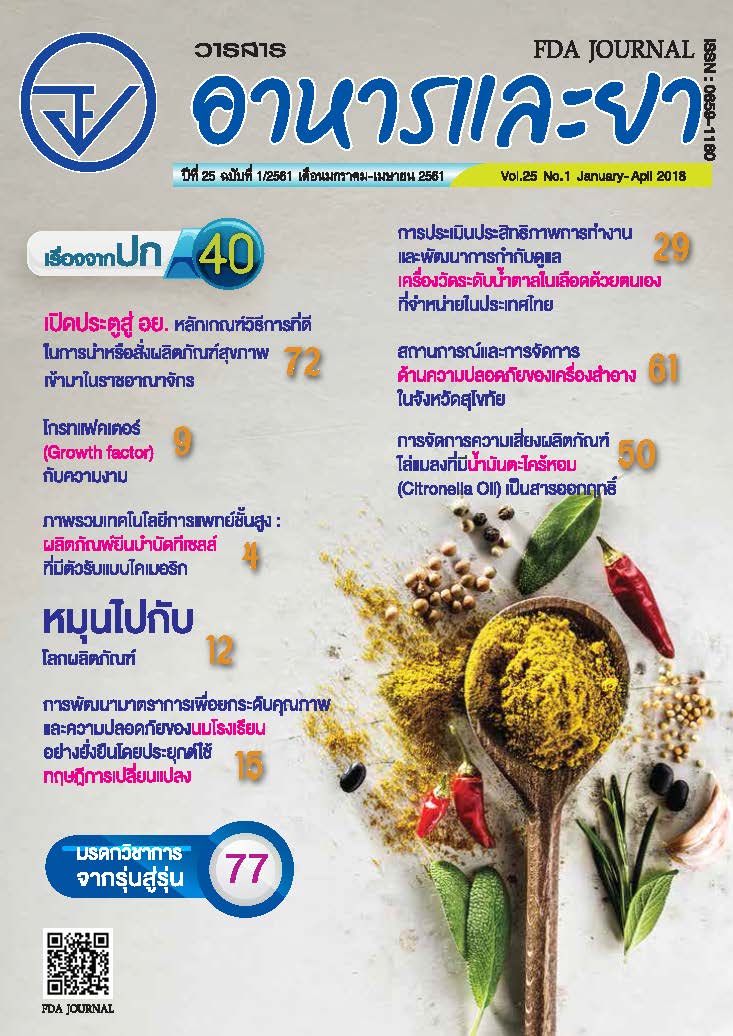การจัดการความเสี่ยงผลิตภัณฑ์ไล่แมลงที่มีน้ำมันตะไคร้หอม (Citronella Oil) เป็นสารออกฤทธิ์
Main Article Content
บทคัดย่อ
นับแต่เมื่อได้ปรับระดับการควบคุมผลิตภัณฑ์ไล่แมลงที่มีน้ำมันตะไคร้หอม(Citronella Oil) จากวัตถุอันตราย ชนิดที่ 2 เป็นวัตถุอันตราย ชนิดที่ 1 ตั้งแต่ปี 2555 เป็นต้นมาพบว่าผู้ประกอบการสนใจผลิตและนำเข้าผลิตภัณฑ์ไล่แมลงที่มีน้ำมันตะไคร้หอม เป็นสารออกฤทธิ์มากขึ้น เนื่องจากขั้นตอนการแจ้งข้อเท็จจริงเกี่ยวกับวัตถุอันตราย ชนิดที่ 1 ไม่ยุ่งยาก ใช้เวลารวดเร็วและจัดเตรียมเอกสารน้อยกว่าการขอขึ้นทะเบียนวัตถุอันตราย ชนิดที่ 2 ประกอบกับผู้บริโภคนิยมใช้ผลิตภัณฑ์จากน้ำมันตะไคร้หอมเพิ่มมากขึ้นเนื่องจากมีความปลอดภัยในการใช้ จึงทำให้ผลิตภัณฑ์ไล่แมลงน้ำมันตะไคร้หอมที่มีจำหน่ายในท้องตลาด มีความหลากหลายและเพิ่มจำนวนอย่างรวดเร็ว ในปีงบประมาณ พ.ศ.2558-2559 มีผู้ร้องเรียนขอให้ตรวจสอบประสิทธิภาพในการไล่แมลงของผลิตภัณฑ์จำนวน 6 ผลิตภัณฑ์ ผลการวิเคราะห์ประสิทธิภาพของผลิตภัณฑ์ 6 รายการพบว่าตกมาตรฐานทั้งหมด จึงมีความเสี่ยงที่ผู้บริโภคจะได้รับสินค้าที่ไม่มีประสิทธิภาพในการไล่แมลงตามที่กล่าวอ้างบนฉลาก ซึ่งอาจเป็นไปได้ว่าอาจเนื่องมาจากในขั้นตอนการยื่นแจ้งข้อเท็จจริงเกี่ยวกับวัตถุอันตราย ชนิดที่ 1 ไม่ได้กำหนดให้ต้องยื่นผลการทดสอบประสิทธิภาพประกอบการพิจารณา รายงานการศึกษาวิจัยฉบับนี้ จึงมีวัตถุประสงค์ เพื่อทบทวนมาตรการกำกับดูแลผลิตภัณฑ์ไล่แมลงที่มีน้ำมันตะไคร้หอม (Citronella Oil)เป็นสารออกฤทธิ์ และเพื่อค้นหาความเสี่ยงในแต่ละขั้นตอนของมาตรการในปัจจุบัน รวมทั้งความเสี่ยงที่อาจเกิดขึ้นจากผลิตภัณฑ์เอง วิธีการศึกษา การศึกษาครั้งนี้แบ่งเป็น 2 ส่วน คือ การศึกษาเชิงคุณภาพ โดยการรวบรวมข้อมูลเอกสารที่เกี่ยวข้องจากแหล่งข้อมูลทุติยภูมิ และการศึกษาเชิงปริมาณ โดยสุ่มตัวอย่างฉลากผลิตภัณฑ์ที่จำหน่ายในท้องตลาดโดยวิธีเจาะจง (purposive sampling) ระหว่างวันที่ 1-30 เมษายน 2560 ผลการศึกษา พบว่าจากการตรวจสอบฉลากผลิตภัณฑ์จำนวน 24 ผลิตภัณฑ์ มีเพียง 2 ผลิตภัณฑ์ที่มีข้อความครบถ้วนถูกต้องตามข้อกำหนดเกี่ยวกับการแสดงฉลากวัตถุอันตราย และพบว่า มี 6 ผลิตภัณฑ์ที่ไม่มีข้อความเข้าข่ายโอ้อวดเกินจริง ลักษณะของข้อความโอ้อวดเกินจริงที่พบมากที่สุดเป็นข้อความโอ้อวดกินจริงในด้านประสิทธิภาพและความปลอดภัยโดยพบ จำนวน 11 ผลิตภัณฑ์ ประโยชน์ที่ได้รับ ข้อเสนอมาตรการในการจัดการความเสี่ยงจำนวน 4 ด้าน ได้แก่ มาตรการส่งเสริมและสนับสนุนให้ผู้ประกอบการการดำเนินการได้อย่างถูกต้องตามกฎหมาย มาตรการด้านการตรวจสอบเฝ้าระวัง มาตรการด้านการบังคับใช้กฎหมาย และมาตรการสื่อสารความเสี่ยงต่อไป
Article Details
เอกสารอ้างอิง
2.คำนวณ อึ้งชูศักดิ์. (2560).การจัดการความเสี่ยงกรณีศึกษา “หน่อไม้ปี๊บ”.เอกสารประกอบการ ฝึกอบรมวิชาความชำนาญด้านการวิเคราะห์การจัดการความเสี่ยงในงานคุ้มครองผู้บริโภค,วิทยาลัยการคุ้มครองผู้บริโภคด้านยาและสุขภาพแห่งประเทศไทย. ปีการศึกษา 2559.
3.United States Environmental Protection Agency. (1997). R.E.D. FACTS Oil of Citronella [On-line]. United States Environmental Protection Agency. . Retrieved January 14, 2016. https://www3.epa.gov/pesticides/chem_search/reg_actions/reregistration/fs_PC-021901_1-Feb-97.pdf
4.University of Hertfordshire. (2015). Citronella oil [On-line]. PPDB. Retrieved January 24, 2017. website http://sitem.herts.ac.uk/aeru/ppdb/en/Reports/1463.htm
5.ประกาศกระทรวงสาธารณสุข เรื่อง ฉลากของวัตถุอันตรายที่สำนักงานคณะกรรมการอาหารและยารับผิดชอบ พ.ศ. 2558, (2558, 15 กันยายน) ราชกิจจานุเบกษา. เล่ม 132 ตอนพิเศษ 219 ง, หน้า 4-6.
6.ประกาศกระทรวงสาธารณสุข เรื่อง การแจ้งข้อเท็จจริงเกี่ยวกับวัตถุอันตรายชนิดที่1ที่สำนักงานคณะกรรมการ อาหารและยารับผิดชอบ พ.ศ. 2549, (2549, 19 มกราคม) ราชกิจจานุเบกษา. เล่ม 12- ตอนพิเศษ 7 ง, หน้า 4-5.
7. United States Environmental Protection Agency. (2017). Conditions for Minimum Risk Pesticides [On-line]. United States Environmental Protection Agency. Retrieved January 24, 2017. website https://www.epa.gov/minimum-risk-pesticides/conditions-minimum-risk-pesticides
8. พระราชบัญญัติวัตถุอันตราย พ.ศ. 2535, (2535, 6 เมษายน) ราชกิจจานุเบกษา. เล่ม 109 ตอน 39, หน้า 21.
9.พระราชบัญญัติเครื่องสำอาง พ.ศ. 2558, (2558, 8 กันยายน) ราชกิจจานุเบกษา. เล่ม 132 ตอน 86 ก, หน้า 5-25.


